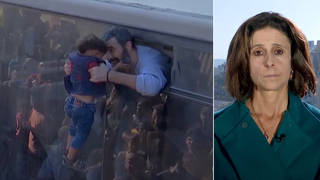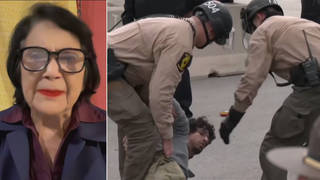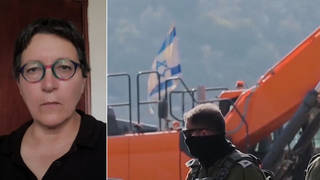
Ariel Castro was arraigned in a Cleveland court today on charges of kidnapping three young women and holding them captive in his house for 10 years. All three women — Amanda Berry, Gina DeJesus and Michele Knight — had vanished in seemingly separate cases when they were between the ages of 14 and 21. Berry’s six-year-old daughter, who was born in captivity, was also rescued. Officials said the three women were at times bound in chains or rope, and endured starvation, beatings and sexual assaults. Eric Sandy, a reporter at the weekly newspaper Cleveland Scene, joins us to discuss Castro’s background, including the brutal abuse of his ex-wife for which he was never jailed.
Transcript
JUAN GONZÁLEZ: We begin today’s show in Cleveland, where a former school bus driver named Ariel Castro is due in court today to face the charges he kidnapped three young women and held them captive in his house for 10 years. Their imprisonment came to an end on Monday when a 911 dispatch operator received this phone call.
AMANDA BERRY: Hello, police. Help me! I’m Amanda Berry.
911 DISPATCH OPERATOR: You need police, fire or ambulance?
AMANDA BERRY: I need police.
911 DISPATCH OPERATOR: OK, and what’s going on there?
AMANDA BERRY: I’ve been kidnapped, and I’ve been missing for 10 years, and I’m—I’m here. I’m free now.
JUAN GONZÁLEZ: That was the voice of Amanda Berry. She had been missing since 2003. Police soon rescued Gina DeJesus and Michele Knight inside the same Cleveland house. Berry’s six-year-old daughter, who was born in captivity, was also rescued. All three women had vanished in seemingly separate cases when they were between the ages of 14 and 21. Amanda Berry and Gina DeJesus have returned to their homes. Michele Knight is still in the hospital, where she was listed in good condition.
Officials said the three women were at times bound in chains or rope, and endured starvation, beatings and sexual assaults. On Wednesday, authorities announced charges against their alleged captor, Ariel Castro. City of Cleveland prosecutor Victor Perez detailed the charges.
VICTOR PEREZ: Regarding this case, I just signed criminal complaints charging Ariel Castro with four counts of kidnapping and three counts of rape. These seven criminal complaints are first-degree felonies.
AMY GOODMAN: Ariel Castro had been initially arrested along with his two brothers, but on Wednesday authorities said the brothers will not face charges. Questions are now being raised about whether police negligence prolonged the victims’ captivity. Several neighbors have said they had called police in recent years to report alarming activity. One neighbor, Israel Lugo, said he and his family called the police after seeing women chained naked in the backyard of the home.
ISRAEL LUGO: My niece seen a naked girl in the backyard. And that same day, four old ladies came from the business around the corner saying the same thing, that they seen four—that they’d seen three girls in the backyard with dog chains on them and with three guys back there abusing them, that they called the police, and them little old ladies sat there for two hours, and the police never showed up.
REPORTER: And what did your sister see?
ISRAEL LUGO: She said she heard and seen like a girl and a lady up in the window pounding on the window, asking for help. So I turned around, and I walked to the house. I didn’t see nothing. I called the police. Twenty minutes later on, police come by. They pound on—no answer, and they leave, you know? It’s like—it’s just like [inaudible], you know what I’m saying? Do you think they did their job? No, I don’t think they did their job.
AMY GOODMAN: The police say they have no records indicating any such calls were made.
For more on the story, we first go to Cleveland to Eric Sandy, a reporter at the Cleveland Scene, a weekly newspaper, who has written a number of articles now on the case.
Sandy, tell us what you know so far, the latest news, the story of what is known at this point and what isn’t known.
ERIC SANDY: Exactly, and—
AMY GOODMAN: Eric, sorry.
ERIC SANDY: And good morning, Amy.
Basically, what we know is a lot of these headlines that you have recapped so far. The story began Monday evening when Amanda Berry tried to escape the home, and the door was still chained. So, thanks to the help of neighbors Angel Cordero and Charles Ramsey, she managed to get out and get a hold of a 911 call, and Charles Ramsey also called 911. Police arrived shortly thereafter and also rescued Gina DeJesus and Michele Knight from within the home. They were treated at Metro Health Medical Center, about 10 blocks away. Michele Knight remains in good condition in the hospital as of right now. Amanda and Gina are home safe as of yesterday afternoon, as is Amanda’s daughter, six-year-old daughter, who was born in captivity.
So, since then, charges have been—charges are being formally made against Ariel Castro this hour. They were announced yesterday at around 5:00 p.m. And his brothers—no charges have been made against his brothers Pedro and Onil. They are appearing in local court this morning for unrelated misdemeanor charges for which they had an outstanding warrant.
So, as of the end of yesterday, some of the big news that came out was the search of Ariel Castro’s home on Seymour Avenue has been completed. More than 200 items of evidence have been taken into FBI custody. That includes, as far as we know, chains, various restraint devices, and, according to sources, at least some sort of letter from Ariel Castro that may include a bit of admission of what he’s been doing.
So, going forward, a lot of those facts are known. The scope of the questions is being broadened to include police action over the past 10 years, police action this week, and basically the how of this matter. A lot of the what and the who, the when and the where, they’ve been answered. But the conversation has been ongoing since Monday evening and has been broadening since then.
JUAN GONZÁLEZ: But, Eric, first go back to this issue of the two brothers, because all three of their disheveled pictures were broadcast around the world, and now suddenly the police said that—and neither of the other two brothers lived in the particular house. So do you have any indication why the police arrested them, as well, initially?
ERIC SANDY: The one word that sort of came out from the police department was “chaos.” Just in the chaos of Monday evening’s events, they managed to take Pedro and Onil into custody, as well. You’re right: They lived a few blocks away; they did not live at 2207 Seymour Avenue. And according to questioning at this point, they had no idea what was going on at their brother Ariel’s home. Again, they are appearing in court on unrelated misdemeanor charges stemming from outstanding warrants, but they apparently have no connection to this kidnapping case.
AMY GOODMAN: Eric Sandy, you wrote the piece “The Long History of Ariel Castro, Cleveland Kidnapper and Monster.” What is known about this suspect, about the former bus driver?
ERIC SANDY: Right. Well, he was a former bus driver. He was most recently fired from the Cleveland Metropolitan School District last November for making an illegal U-turn. But going back a few years reveals a bit of a fractured family history and at least one run-in with police in 2004 as a bus driver. He left a child on a bus and left the bus for several hours. The county’s Department of Child and Family Services showed up at his home. This is 2207 Seymour. This is 2004, and at least two women were being held at the home at that time, allegedly. And they knocked on the door, and there was no answer, and that was that. He was suspended, stemming from that incident, but that was really the one interaction with any semblance of—with law enforcement.
More privately, he—at one point, him and his wife separated. And they have a very contentious relationship. She actually died recently. And she lived with another man, Fernando Colon, her husband, and Ariel Castro’s children lived with them. Basically, throughout the past 10 years, no one was really allowed in 2207 Seymour. Ariel made sure of that. Again, his children lived with their mother and their stepfather. And at one point, Fernando Colon, their stepfather, was a suspect in the disappearance of at least Gina DeJesus, and quite possibly the other two women, as well. He was cleared following a polygraph test and questioning. And according to our sources and according to Fernando, he pointed to Ariel Castro as a suspect. Now, the FBI has admitted that Fernando was a suspect in the kidnappings, but they have said that he did not point to Ariel Castro. And regardless, there was no follow-up into Ariel Castro as a suspect at that time. There were also many accusations of domestic violence against Ariel Castro from his ex-wife.
AMY GOODMAN: Now, this is extremely significant.
ERIC SANDY: Right.
AMY GOODMAN: Can you talk about the brutality?
ERIC SANDY: Absolutely. Earlier in the past 10 years, there was one case that went to court involving him breaking her nose, breaking—dislocating a—
AMY GOODMAN: This is Ariel Castro breaking his ex-wife nose—his ex-wife’s nose.
ERIC SANDY: This is Ariel—this is Ariel Castro breaking his ex-wife’s nose, dislocating her shoulders, and at one point beating her so hard a blood clot formed on her brain. Again, this is a pretty indicative illustration of what that relationship was like and where the children came from, and sort of explains the family history a bit.
JUAN GONZÁLEZ: But what was the—what was the result of those charges for him?
ERIC SANDY: Yeah, well, there was—there was no jail time. There was no—he was not taken into custody or arrested. He was—you know, they were separated from that point onward, really.
AMY GOODMAN: I mean, if she was a stranger on the street, right, he would have been charged with assault and gone to jail. But she’s his wife, his ex-wife, and he doesn’t go to jail. And now he is charged with what we see now. Now, wasn’t he the main source of information that her husband abused their daughters, his daughters, and ended up having him sent to jail?
ERIC SANDY: He was a very significant source of information. And his daughters were alleging sexual impropriety during that time against Fernando Colon. And from what we’ve gathered, Ariel Castro did encourage them to go forward with this information. In a sense, he bought them gifts throughout the time, again, after being essentially not a very visible father figure in their life, and made sure that that court case against Fernando Colon went forward. He testified against Fernando, and the ex-wife and actually Ariel Castro’s son, also named Ariel Castro, testified on Fernando’s behalf. There were 27 counts filed against Fernando Colon. They were dropped to just four counts, and he ended up just doing three months of essentially being under watch by the county. He was never taken to jail, and thus there was less of an incentive to appeal. And that’s how that ended.
JUAN GONZÁLEZ: And, Eric, what can you tell us about the history of the Cleveland Police Department—they’re under a federal review, a Justice Department review, right now—and, generally speaking, the department’s—criticisms of department activities in the past?
ERIC SANDY: Right. Especially in recent years, there is a very heavy amount of skepticism against the police department here in Cleveland. This most latest incident, again, there’s a variety of stories surfacing right now alleging possible negligence. We are all looking into those stories.
But to go back into recent cases, most recently, on November 29th last year, dozens of policemen were involved in a police chase in downtown Cleveland that went into East Cleveland. It ended in a shootout. They were pursuing one vehicle with a driver and a passenger, and it ended in a shootout. A hundred thirty-seven bullets were fired. Both the driver and the passenger were killed, and they were found later to be unarmed—and thus the Department of Justice investigation.
Going back a few years, several other very high-profile instances sort of stirred up skepticism, and the most significant being the case of Anthony Sowell in 2011. He was convicted of multiple murders. He was essentially killing women and stashing their bodies in an Imperial Avenue home on the east side of town. Much like this case, although, again, in different circumstances, the case of Anthony Sowell was brought to light by neighbors. They sort of alerted police to various smells and sensory—sensory descriptions of the house. Again, with this week’s news, it only came about once Amanda Berry tried to escape the house, and Charles Ramsey and Angel Cordero helped her, calling 911 at that point.
And so, those are some of the—it’s a significant amount of background information here and a significant reason why a lot of charges are being conversationally leveled against the police department. That’s sort of the backdrop we’re working with here.
JUAN GONZÁLEZ: And how many women was Sowell convicted of killing?
ERIC SANDY: I don’t know offhand, but multiple. He—this was a serial murderer. And it’s—that came to light a few years ago.
AMY GOODMAN: Also, just the area that this house was, where the women were held in captivity—and, we understand, Amanda’s child, as well—abandoned houses next door, commercial area behind it, and raises the question of how the Cleveland police deal with a poor area like this. But, Eric Sandy, we’re going to keep you on, and we’re going to continue with this discussion and bring someone else in to talk about rape culture. Eric Sandy is staff writer at the Cleveland Scene, a weekly newspaper. Stay with us.












Media Options